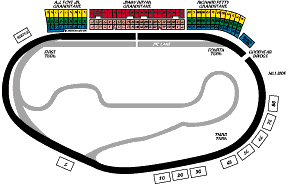
[Note: This wasn't written as an official "Urb's Column," but I thought I should add it to the column list along with the other "On the road" columns, since it's related material... ed.]
Here's a summary of my experiences in Keith Code's California Superbike School on October 13, 1997 at Phoenix International Raceway [note: I also took the school's Level 2 at Road America on June 8, 1998 and again in June, 1999; see the picture at the bottom of the page]. I was riding one of the school's Kawasaki ZX-6Rs.
This is a diagram of the racetrack at Phoenix. For motorcycle racing, the track is set up so that Turn 1 cuts into the infield (shown in gray). The track continues through the infield until the left-hand hairpin turn takes you back onto the oval (bottom of the diagram). The carousel right-hander was the most difficult turn on the track, followed closely by the hairpin -- or at least that's how I'd rate them.

The basic program that you take when you're in the school for the first time consists of five lessons, each of which is a brief classroom session followed by about 20 minutes on the track. The advanced group (of riders who've taken the school a bunch of times) gets more into "making friends with the curves" and that sort of thing, he says.
Anyhow, the first session was on "no brakes, no shifting" laps, using one gear (Keith suggested 5th, but I, being the second-slowest rider on the track, used 4th. I only passed one rider all day, that being a gal on a 600 Honda Shadow).
Here I am (number 2), waiting to be sent out on the track:

Throughout the first session, I was very tentative, as I got the feel
of the bike, the racetrack, and so forth. One of the instructors
(the bikes are color-coded with tape -- there are about four track instructors,
each of whom takes care of one color group) pulled me into the pits and
said, "What you're doing looks good." I was still pretty tentative,
but then, the second lesson was
on finding entry points for curves, and the whole go-in-deep, apex-late
thing. To help us out, they went out and taped big yellow X's on
the track, at the turn points for each corner. We were still using
no brakes (unless you made a mistake and approached a corner too fast)
and no shifting. With the turn points indicated, I got much better
-- my lap times were 15-20 seconds faster; the instructor pulled me over
again, and I told him, "I'm not afraid of the track anymore!"
The third lesson was on making steering inputs quickly. Code said
that your steering input (there should only be one motion in the corner
-- a quick countersteer/lean, then you hold your position throughout the
turn, with the exception of rolling on the throttle) should be as quick
as possible. Once again, the improvement out on the track was unbelievable
-- I was making the
corners much faster and more confidently than before. My lap
times dropped by another five seconds or so.
The thing about the program is that he keeps adding another little wrinkle each time, isolating the things that go into cornering, and you work on adding one at a time, seeing the difference each one makes.
Here, I'm coming around Turn 3 (I think), blasting through the infield portion of the track:

Anyhow, the fourth lesson was on minimizing rider input during turns, and being relaxed, minimizing tension. Again, it made a phenomenal difference. It was around this time that I started going much faster -- really started winding the bike up around the oval. Once you get the ZX-6R up to around 10,000 RPM, it really starts to go! I got my lap times down another five seconds or so -- mind you, they were still pretty slow (my best lap was 1:48, which I think works out to an average speed of 50mph or so; for perspective, I think the lap record at Phoenix is around 1:10 -- but hey, I'm a touring rider).
The last lesson was on two-step turn entry -- looking into the turn half a second or so before you reach the entry point. Once more, it made a huge difference -- the track opens up enormously when you're looking ahead before you turn, instead of at the same time.
Mind you, I was still slower than most of the other riders -- but I was getting passed a lot less at the end of the day than at the beginning! The instructors are really helpful -- as I mentioned, they'll signal you into the pits every once in awhile, and help you with something; my instructor helped me at the end of the day, with the two-step thing. He had me follow him through the most difficult corner on the track a couple of times; that helped a lot.
Anyhow, it was a great time and a terrific learning experience; highly recommended. If you're interested in trying it yourself, you can contact the California Superbike School directly.
Here's a shot of me -- same bike, different leathers -- at their Road America session:

Copyright © 2000 John J. Kafalas